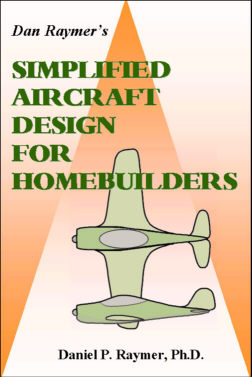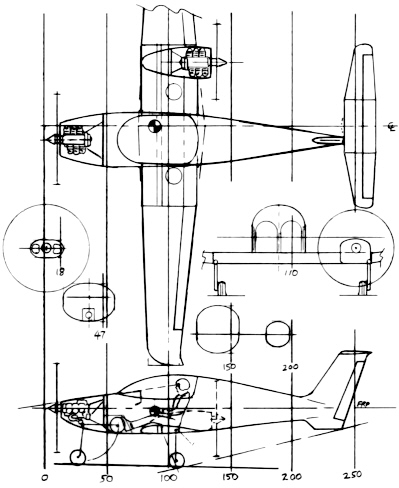
Dr. Daniel P. Raymer, author of the award-winning textbook “Aircraft Design: A Conceptual Approach”, tells the non-engineer how to create a design concept that really could be built and flown!

Paperback, 160 pages, $49.95
Design Dimension Press, Los Angeles, CA, 2003
ISBN 0-9722397-0-7
- Easy-to-follow, step-by-step methods to lay out, analyze, and optimize your new homebuilt aircraft concept
- Industry methods distilled to the essence, and written in a straight forward, easy-to-read style
- No derivations, proofs, or complicated equations
- Every step is illustrated with an all-new design example that is followed through from beginning to end
I love your “Simplified Aircraft Design for Homebuilders” book. I have purchased several dozen expensive aircraft design books, but none of them give me the practical and easy to use knowledge that I got from “Simplified Aircraft Design for Homebuilders”. Raymer does an excellent job of presenting the needed information in a clear and easy to understand manner without the reader needing to be a whiz at advanced math. The free design spreadsheet that comes with the book does all of the heavy lifting on the math side. Brian Kraut, EA Manufacturing
This is a great new book – I finally have a book to suggest when I get an e-mail saying “I’m a homebuilder who wants to design an airplane – could you recommend a book?” David Lednicer, Analytical Methods Inc. and author/webmaster of the Incomplete Guide to Airfoil Usage
I really do love your book “Simplified Aircraft Design for Homebuilders”. I am going to order a few more copies and give some as gifts to my flying friends. John Yates, former Chief Operating Officer of Kolb Aircraft Co.
Combines professional experience with an unusual directness and clarity of expression. Peter Garrison, Flying Magazine
I can’t thank you enough for your homebuilt design book. The light came on. I’ve got your textbook, now, and I’m designing an aircraft and plowing through it… yours is the first book on aircraft design I understand. Now, I understand the other books. (/i) Troy Bentz
A well-written book. My personal favorite: footnote on page 113. I don’t think I’ve cracked up (laughed) reading an aero book before. Todd Ashcraft
Congratulations on another contribution to aviation! I read it cover to cover. Your narrative writing style will connect well with the intended users…a fine addition to my library. Harry Scott, Program Manager & Configuration Designer, Rockwell North American Aviation (configuration designer of Space Shuttle)
Indeed it is a wonderful book. Captain Asif Majeed (Pakistan Army), BE Aeronautical Engineering, Helicopter Maintenance Engineer
As an amateur designing and building an airplane, I got much more out of “Simplified Aircraft Design For Homebuilders” than from other aircraft design books, including the expensive volumes published by (withheld). Your book is well-written on the basic level for the homebuilder and you’ve gone to great lengths to include the details that are so difficult for the amateur to research. Alex Itenson, Experimental Aircraft Designer/Builder
From the Foreword by Peter Garrison, designer/builder of Melmoth and author of Technicalities Column, Flying Magazine:
The great problem for the beginning designer is integration: to know how to think about the multifaceted task ahead, in which every choice influences every other one so intimately that it seems impossible to know where to start.Dan Raymer has a knack for cutting through this Gordian knot. His remarkable textbook, Aircraft Design: A Conceptual Approach, manages to bring together every aspect of airplane design at the precise intersection of the theoretical and the practical. It combines professional experience with an unusual directness and clarity of expression.
The book you hold in your hands does the same, but at an even more accessible level, and with reference to the class of airplane that an amateur designer is likely to undertake. It shows you how to think about the problem; what steps to take to begin a design, and in what order. It introduces you to the complete spectrum of the designer’s concerns and arms you with a vocabulary of concepts that you will flesh out through further reading. It won’t — can’t — be the last book on airplane design that you buy; but it should be the first. I wish I’d had it in 1963. -Peter Garrison, Los Angeles, CA, Oct 2002
The following material, excerpted from Chapter One, introduces the book:
This book follows, step-by-step, the design of your aircraft concept. No introductory lessons in aerodynamics, no math review, and especially, no derivation of equations! The design steps in this book will work for most concepts, and you should be able to figure out how to modify the method if you have something unusual to consider.
We begin by deciding what you want your homebuilt to do, and how to set your design requirements. Next, your requirements are used to estimate how big the aircraft should be, how big the wing should be, and how big an engine you should buy. If you already have selected an engine, you’ll work backwards to determine what airplane capabilities you can hope to get out of that engine.
Selection of wing geometry comes next, along with airfoil selection and tail geometry and size.
Following that is a discussion of the things that you must put inside the aircraft. These include yourself and the passengers and baggage. Landing gear design, engine installation, propeller sizing, and fuel tank design are then considered.
Then come the methods used to ‘loft’ your airplane. This is the actual creation of the drawing, and the book explains how to develop smooth external shapes either on a drafting table or in a CAD system.
Methods are given for analyzing the airplane you just drew, including aerodynamics, structure, weights, stability, propulsion, and performance. Last comes an introduction to design optimization – how to change your design to make a better airplane.
Table of Contents:
Foreword By Peter Garrison
Chapter 1 Introduction
Who Am I And Why Did I Write This Book?
What Is A Homebuilt?
A Plain Plan For Plane Planning
Step Right Up, Get Your Free Design Software
Please Read The Following Cautions:
Chapter 2 So, You Want To Design A Homebuilt?
Why?
What Do You Want It To Do?
So, Raymer Wants To Design A Homebuilt
Chapter 3 How Big Should It Be?
Power Loading
Wing Loading
Airplane Sizing
Engine Sizing And Selection
Wing Geometry
Airfoil Selection
Tail Geometry
Fuselage Size
Chapter 4 Stuff In Some Stuff
You And Me And A Dog Or Three
The Rubber Meets The Road
In Goes The Engine
Stuff Some Structure
Fuel Tanks
Chapter 5 Draw A Smooth Outside
Conic Lofting
Flat-Wrap Lofting
Wing/Tail Lofting
Raymer’s Dr-4 Safety Twin
Measure What You Drew
Chapter 6 Buckle Up For Safety
Crashworthiness
Flutter
Chapter 7 Analyze It
Aerodynamics
Propulsion
Preliminary Structural Sizing
Weights Estimation
Stability
Chapter 8 Range & Performance
Stall Speed
Takeoff Distance
Rate Of Climb
Maximum And Cruising Speed
Range
Help – I Didn’t Get The Range/Performance I Wanted!
Chapter 9 Let‘s Make It Better!
Chapter 10 And In Conclusion..

Amazon.com Book Review
Excellent first book for wannabe homebuilt aircraft designers
A reader from Cedar Ridge, CA: Most aircraft design texts are university textbooks or industry references, and out of hundreds of pages you might find a few dozen that are helpful for the amateur experimental aircraft designer/homebuilder. This book, however, wastes not a single page. After the obligatory “don’t blame me if you kill yourself” intro, the book gets right down to business.
…one of the most detailed and useful descriptions of conic and flat-wrap lofting I’ve seen in any design reference.
…I commend the author for a halfway-decent overview of structural design–most of the aerodynamically-oriented texts seem to be afraid to touch this topic.
…brief but great appendix with useful tables and graphs, such as the weight and horsepower of most of the engines commonly seen on homebuilts and the weight and density of common homebuilt aircraft materials and components.

Dan Raymer’s Simplified Aircraft Design for Homebuilders can be ordered at Atlas Books (publisher’s fulfillment house) or at Amazon.Com.
(Users of certain browsers may have difficulty downloading the file – if so click here to request that it be emailed to you)